Class 10 Biology Notes For Respiration
What Is Respiration? Define Respiratory Substrate.
Respiration is a multistep enzymatic breakdown of organic compounds like glucose that releases small packets of energy at various steps. Glucose that is commonly broken down in respiration is called respiratory substrate. In the aerobic type of respiration, oxygen is used as a terminal oxidant. Besides energy, carbon dioxide is released.
respiration definition
Class 10 Biology Notes For Respiration Experiment
Carbon Dioxide Is Released During Respiration
Take two test tubes. Half-fill them with freshly prepared lime water. Blow air into one test tube by means of a tube. Note the time taken by lime water to turn milky. Now, blow fresh air into the second test tube by means of a syringe (or Pichkari). Repeatedly do it till lime water turns milky. Note the time taken. Compare the two time periods.
Lime water turns milky only when it reacts with carbon dioxide. Air blown out of the mouth is the one which has come out from the lungs. As it turns lime water milky very soon, it is clear that respiration releases carbon dioxide. ‘Atmospheric air contains comparatively very low concentrations of carbon dioxide as it takes a long time to change lime water milky.
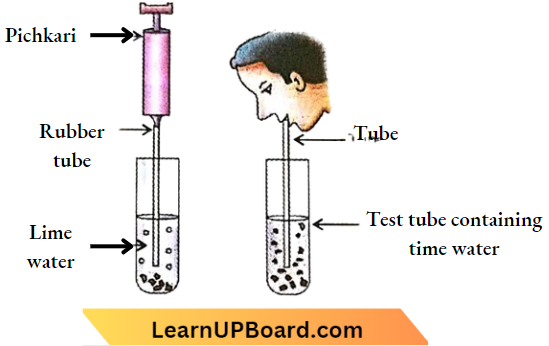
what is respiration class 10
Class 10 Biology Notes For Respiration Cellular Respiration
What Is Cellular Respiration?
Break-down of respiratory substances occurs only inside living cells. It is, therefore, called cellular respiration. Oxygen used in cellular respiration and carbon dioxide produced by it are called respirators or metabolic gases.
Complex animals have three more steps for respiration—breathing, external respirator’ exchange and internal respiratory exchange. There is a direct respiratory exchange of gases in simple animals and most plants.
Types of cellular respiration
Class 10 Biology Notes For Respiration Release Of Energy ATP
How Much Energy Is Released By Breakdown Of One Molecule Of Glucose?
Respiration releases energy in small steps. A part of this energy is dissipated as heat while another part is used in the formation of adenosine triphosphate (ATP).
![]()
About 50% of the released energy is used in the formation of ATP from ADP and inorganic phosphate (Pi or P)
ADP + Pi or (P) + Energy ↔ ATP or ADP ∼ (P)
About 30.5 kJ or 7.3 kcal of energy is used in the synthesis of one molecule of ATP from ADP and Pi. The same energy is released whenever energy is required for any activity of the cell. ATP functions as the energy currency of the cell.
The energy is used in various functions of the cell (just as a batter) and can be used to provide electricity for diverse activities) for example, muscle contraction, nerve conduction, membrane permeability, active absorption, cyclosis or cytoplasmic streaming, working of genetic system, biosynthesis, etc.
describe the process of respiration
Class 10 Biology Notes For Respiration Respiration And Photosynthesis
What Is The Difference Between Respiration And Photosynthesis?
Respiration is a breakdown or catabolic process which releases energy stored in chemical bonds of the respiratory substrate. Photosynthesis is a build-up or anabolic process which traps solar energy and uses the same in the formation of chemical bonds in organic compounds. The two processes are complementary as the products of one are used as raw materials for the other.

Photosynthesis occurs only during the daytime in green cells. Respiration occurs all the time in all the living cells. However, the rate of photosynthesis is several times the rate of respiration, so a lot of food gets stored in plants after meeting their respiratory requirement.
Differences Between Respiration And Photosynthesis
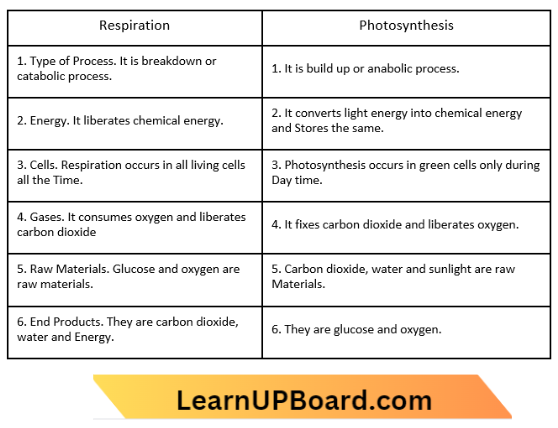
Class 10 Biology Notes For Respiration Types Of Respiration
Respiration is of two types: anaerobic and anaerobic.
Aerobic Respiration. It is a mode of respiration in which the respiratory substrate is completely oxidised to form carbon dioxide and water. It is the common mode of respiration since it yields the maximum energy contained in the respiratory substrate.
characteristics of respiration

A part of the liberated energy is stored in some 38 ATP molecules. The rest is dissipated.
Aerobic respiration occurs in two steps, cytoplasmic and mitochondrial.
1. In cytoplasm glucose is broken into two molecules of 3-carbon compound pyruvic acid. Two ATP and two NADH2 are also formed. This cytoplasmic step is called glycolysis.

2. In mitochondria one pyruvic acid undergoes decarboxylation and dehydrogenation to form 4NADH2, one FADH2; one ATP and 3 molecules of carbon dioxide.

The mitochondrial step is called the Krebs cycle after the scientist who discovered it in 1940. Both NADH2 and FADH2, are used in mitochondria to form ATP molecules through a process called oxidative phosphorylation. One NADH-, produces 3 ATP molecules while one FADH2 forms two ATP molecules.
Total NADH2 formed in aerobic respiration = Glycolysis – 2NADH2
Kreb’s cycle — 4 NADH2 x 2 = 8NADH2
Total FADH2 formed in aerobic respiration = 1 FADH2 x 2 = 2FADH2
Direct ATP formed = Glycolysis – 2ATP = Kreb’s cycle – 1 ATP x 2 = 2ATP
From 10 NADH2, 10 x 3 = 30, From FADH2 2 x 2 = 4, Direct ATP = Glycolysis — 2, Krebs’ cycle — 2.
Total 30 + 4 + 4 = 38 ATP
Class 10 Biology Notes For Respiration Anaerobic Respiration
What Is Anaerobic Respiration? Why It Is Uncommon?
It is a breakdown of the respiratory substrate without using oxygen. A complete breakdown into inorganic products is absent At least one product of anaerobic respiration is an organic substance. Anaerobic respiration occurs in the cytoplasm only. It has two components, glycolysis and reduction of pyruvic acid produced in glycolysis.
Anaerobic respiration occurs in many bacteria, yeast and some other microorganisms. In yeast, the most common products are ethyl alcohol (C2H5OH) and carbon dioxide. Anaerobic respiration also occurs in striated muscles during heavy exercise. Here pyruvate is reduced to form lactic acid. Lactic acid causes pain in the muscles and forces the athlete to stop further exercise.
examples of respiration
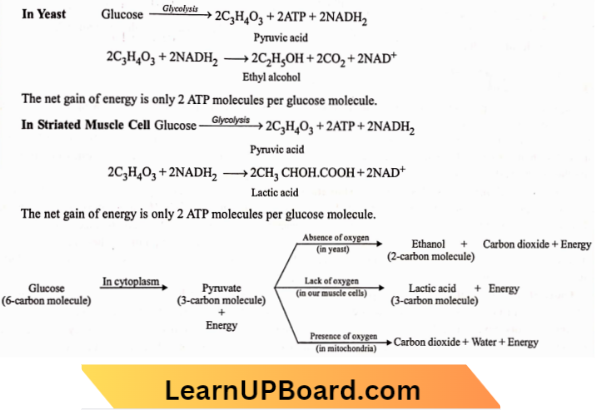
Fermentation. It is an anaerobic breakdown of sugars by microorganisms that is usually accompanied by effervescence or bubbling out of waste gases and the formation of a variety of products like alcohol and organic acids.
The fermentation activity of yeast is used in the baking industry and brewing industries. The formation of yoghurt, curd, idli and dosa is also the fermentation activities of specific bacteria. Acids produced through fermentation include vinegar, citric acid, lactic acid and butyric acid.
Class 10 Biology Notes For Respiration Fermentation Experiment
In Fermentation, Yeast Produces Alcohol And Carbon Dioxide.
Take a test tube. Fill 5/6 of it with 10% glucose solution or some fresh fruit juice. Add half a spoonful of yeast to it. Pour a drop of non-drying oil over the surface of the solution to exclude oxygen. Fit a one-holed cork having a delivery tube into the mouth of the tube.
Dip the free end of the delivery tube in a tube having freshly prepared lime water. Note bubbles of gas coming out of the sugar solution. They pass into lime water. Lime water turns milky indicating that yeast is producing carbon dioxide. Remove the cork and smell the solution. It smells of alcohol. Yeast, therefore, produces alcohol and carbon dioxide during fermentation or anaerobic respiration.
physiology of respiration notes
Differences Between Anaerobic And Aerobic Respiration
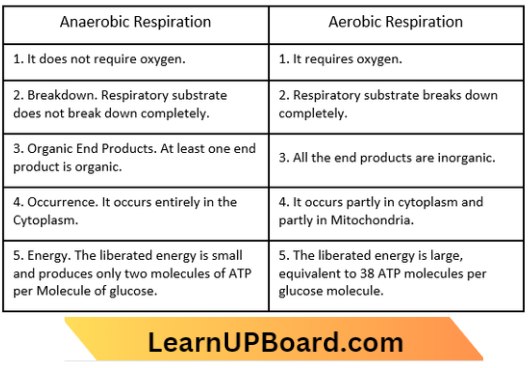
Class 10 Biology Notes For Respiration Exchange Of Gases In Plants
Higher plants respire aerobically. The rate of respiration is different in different parts. Growing points of both stem and roots, cambial cells, floral buds, growing fruits and germinating seeds respire more actively than other parts.
Most parts respire slowly because being fixed, plants have a lower requirement of energy. Plants also do not have any transport system for gases. Instead, they have a well-connected network of intercellular spaces for the diffusion of gases. Even then every part of the plant has its own system of exchange of gases.
Leaves And Young Stems. They possess stomata for gaseous exchange. During day time carbon dioxide is consumed in photosynthesis and oxygen evolves. Stomata help in the inward diffusion of carbon dioxide and the outward diffusion of oxygen. The oxygen required for respiration is generated internally. Similarly, carbon dioxide produced in respiration is consumed in photosynthesis.
At night, plants also require oxygen for respiration. They may also release carbon dioxide. The exchange occurs through some partially opened stomata as well as gases stored in intercellular spaces during the daytime.
Older Stems And Roots. They possess permanently open pores called lenticels. A lenticel has a number of loosely arranged complementary cells. Their interspaces connect atmospheric air with air present in the intercellular spaces.
Young Roots. Epiblema cells and root hairs of young roots are permeable to metabolic gases. They are in contact with small spaces present in between soil particles. Oxygen from soil diffuses into roots while carbon dioxide comes out of the roots into air spaces. Soil air spaces are in contact with soil pores present on the surface of the soil.
However, in waterlogged soil, the soil aerating system disappears. In the absence of oxygen, young roots stop growth and fail to undertake active transport. Cell membranes lose permeability. As a result, the plant devoid of root aeration, withers and may die.
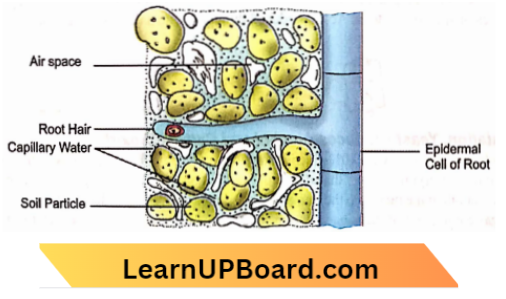
Class 10 Biology Notes For Respiration Multiple Choice Questions And Answers
Question 1. Anaerobic process
- Takes place in yeast during fermentation
- Takes place in the presence of oxygen
- Produces energy only in the muscles of human beings
- Produces ethanol, oxygen and energy.
Answer: 1. Takes place in yeast during fermentation
Class 10 Biology Notes For Respiration Long Answer Type Questions
Question 1. Explain how the exchange of gases occurs in plants across the surface of stem, root and leaves.
Answer:
- Young Stems and Leaves. Through stomata between the atmosphere and intercellular spaces present in leaves and young stems. During daytime oxygen is passed out of them and carbon dioxide is absorbed. During night the reverse exchange of gases occurs.
- Young Roots. There are no pores or stomata. The epiblema and root hairs are permeable to gases so the exchange of gases occurs between intercellular spaces of roots and the soil interspaces.
- Old Stems and Old Roots. Lenticels or permanently open pores occur over the surface of old stems and roots. They are connected internally to intercellular spaces.
- The exchange of gases occurs between the atmosphere and plant interior through the lenticels which have loosely held complementary cells.
